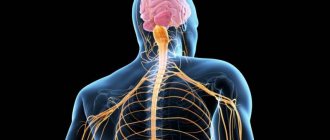Modern society is susceptible to many mental pathologies, among which a separate group are nervous eating disorders, in particular bulimia.
It is noteworthy that men suffer from this disease much less frequently than representatives of the fair half of society, due to a number of reasons that will be discussed further. Bulimia literally means “bovine hunger” in Greek. Other names for this deviation are kinorexia, i.e. wolf hunger. Bulimia nervosa is an eating disorder characterized by regular, uncontrollable bouts of overeating.
The danger is not only the fact of lack of control over the amount of food eaten, but also the subsequent unhealthy concern about controlling body weight. Therefore, most bulimics resort to radical measures designed to neutralize (eliminate) the aftereffect of consumed foods on body weight.
Types of food pathology
Bulimia nervosa has different forms of manifestation, but has a common pattern of eating behavior: periods of uncontrolled food intake alternate with periods of active weight loss. Overeating (hyperphagia) can be:
- paroxysmal;
- permanent nature;
- at night.
A bulimic is unable to independently control outbreaks of irresistible hunger. When starting to eat, a person is unable to stop on his own until he clearly feels pain in the stomach and nausea.
People suffering from bulimia are more concerned about their figure than others. After another attack, they usually feel depressed due to guilt and remorse after what happened. Therefore, patients try in any way to avoid weight gain. For this reason, bulimia is divided into two types:
- classic nervous (cleansing ). She is characterized by a constant preoccupation with food and a desire to consume it in repeated episodes. Getting rid of hyperphagia involves taking drugs that have diuretic and laxative properties, forced gastric emptying (vomiting), and enema;
- compulsive _ Its peculiarity is that uncontrolled preoccupation with food is accompanied by careful monitoring of body weight. This type is characterized by other drastic measures for weight loss - exhausting mono-diets, additional physical activity, conscious fasting. At the same time, bulimics do not rid themselves of what they eat artificially. At a certain point, a person breaks down and begins to absorb food in even greater quantities.
Experts have identified so-called atypical kinorexia .
This subtype has much in common with the classic form of eating disorder. However, an incomplete picture of the clinical manifestations required for a given mental pathology does not provide grounds for a doctor to determine a final diagnosis. The reason for this is an insufficient number of key symptoms of the disease. For example, after overeating and subsequent forced rejection of food, there is a complete absence of concern about being overweight and the desire to have ideal shapes.
Treatment
To treat bulimia, you need to see a psychotherapist. Additionally, if there are symptoms of disorders in the digestive system, a consultation with a gastroenterologist should be scheduled.
Treatment of bulimia is based on the implementation of drug therapy and behavioral therapy. Behavioral therapy is needed to reach the patient: the doctor and relatives of the bulimic need to help him understand the existing problem and find a way to solve it. The duration of therapy can be about 5 months, during which episodes of overeating should decrease. This allows the patient to get rid of addiction.
Drug treatment is focused on restoring lost microelements (magnesium, potassium). Antidepressants are also prescribed to complement behavioral therapy.
Manifestations and signs
The symptoms of kinorexia are determined by pathologically altered eating behavior and additional physiological indicators. The psychosomatics of such a deviation may not be expressed clearly enough, so it is important to pay attention to the auxiliary signs of the disease.
Bulimics are very similar to anorexics, but they are much more difficult to detect. While the latter can be easily identified by their unhealthy thinness, the weight of people with bulimia is close to normal. In addition, they are very ashamed of their addiction, so they try to hide it in various ways. For example, at social events they may simply not touch food, so as not to provoke a food breakdown.
The main signs of this eating disorder are:
- the first signal about the presence of a food pathology is excessive preoccupation with appearance, control of one’s weight;
- a sick person consumes an excessive amount of food at one time. These are mainly foods high in fat, starch, and sweets. A bulimic may leave in the middle of a meal to go to the toilet in order to get rid of what he has eaten. To muffle the sounds of vomiting, a person can specially create the noise of flowing water (turn on the tap, flush water in the drain tank);
- people who have eating pathologies prefer to eat alone and avoid public events;
- the patient's relatives may often notice the disappearance of large amounts of food. However, in order to hide his pathology, the bulimic tries to replace the missing products as quickly as possible even before their significant shortage is discovered;
- among pharmacological drugs such people may have a large number of laxatives;
- during a medical examination, the doctor notes an extreme degree of dehydration or disruption of the normal functioning of the gastrointestinal tract;
- bulimia leads to the destruction of teeth and gums, which can be noticed by the dentist;
- people who suffer from bulimia often complain of pain in the stomach, heartburn, swelling of the extremities, regular dizziness, ruptured capillaries on the face, swelling, women - failure of the cyclicity of menstruation
Additional physiological symptoms:
- haste when eating food, poor chewing;
- isolation in matters related to food;
- frequent attacks of irresistible hunger;
- dynamics of body weight in a positive or negative direction;
- inflammatory processes in the throat area, specific injuries on the fingers and hands that occur due to forced vomiting;
- disorders of the heart, kidneys, and liver.
Doctors state that bouts of overeating are episodic. Most often, the provocateur of such an attack of gluttony is psychosocial stress. Overeating ends in compensatory behavior: a person consciously provokes vomiting, uses special drugs that cleanse the body, significantly increases physical activity, and resorts to fasting.
A mandatory aspect for making a diagnosis of “bulimia nervosa,” in addition to uncontrolled consumption of food, is the patient’s concern about his body weight and his appearance. Most often, bulimics are dissatisfied with their weight and consider it excessive. Paradoxically, obesity or excess weight with bulimia is observed in rare cases.
Patients with kinorexia are more open when contacting a specialist. Doctors believe that the reason for this is the personal concern of such individuals about what is happening, as well as feelings of guilt and shame about this. A clinician who is sympathetic to the patient has the opportunity to obtain from him the most frank information that reflects what is really happening to the person.
Diagnosis of bulimia
The diagnosis of bulimia is based on the following pattern of symptoms:
- recurrence of episodes of overeating;
- obsessive thoughts about food;
- constant struggle with excess weight;
- inducing vomiting or spitting out food;
- low self-esteem.
The doctor needs to clearly distinguish between bulimia and gluttony. Their common symptoms include eating at a fast pace, usually alone. Both disorders can also be a symptom of a psychological disorder. Bulimia is also distinguished by the fact that attacks become a reaction to stress, sadness, frustration, and overeating itself is not spontaneous, but is planned by the patient, who is ashamed of the fact of eating food.
Causes
The basis of the disease is a complex of causes that are biopsychosocial in nature. The consciousness of modern man is influenced by many factors: social, biological, cultural. By promoting certain ideals of beauty, the media programs the population to conform to them. The general situation is aggravated by public opinion and advertising campaigns.
This eating disorder, like any other mental disorder, has both biological and psychological background.
Biological factors in the occurrence of the disease include disruption of the normal functioning of the brain. These include organic damage in the area of the brain center responsible for human nutritional activity, as well as disruption of metabolic processes occurring in the body. Bulimia can also be triggered by traumatic brain injury, brain tumors, or hormonal imbalance that results in disruption of the normal functioning of the pituitary gland or hypothalamus.
The causes of psychological illness are more varied, but they are more difficult to detect. These include:
- emotional stress over a long period of time;
- neuroses of various types;
- low self-esteem;
- depressive states;
- increased anxiety or obsessive mental disorders;
- tendency to heredity.
Bulimia nervosa can develop against the background of excessive enthusiasm for all kinds of diets. Limiting oneself for a long time in favorite foods, after finishing such a “poor” diet, a person literally pounces on food.
Children and adolescents from wealthy families are most susceptible to kinorexia. The high demands that parents place on them lead to the child’s loss of personal self-esteem and its underestimation. Gradually, the still unformed personality begins to “eat up” the lack of warmth and affection from loved ones. At the same time, as already mentioned, an important role is played by the media, which promote standard beauty.
The child, realizing that he eats too much and can no longer refuse it, feverishly begins to look for ways to consume an incommensurate amount of food, but at the same time not lose weight.
It is characteristic that in those countries where excessive “boning” is not considered a standard of beauty, bulimia, as a mental pathology, is very rare.
Consequences
Many people consider bulimia nervosa to be a minor pathology that can be dealt with on their own without the help of a specialist. This misconception can lead to extremely undesirable results that will affect both psychological and physical levels.
The results of an advanced form of the disease may include the following phenomena:
- depression, a depressed state caused by feelings of shame and guilt for one’s behavior;
- there is a sharp change in life values and priorities;
- Communication with other people deteriorates.
The physical consequences manifest themselves as follows:
- a violation of the body's water balance, which occurs with regular use of laxatives or provoked vomiting. These actions also lead to a deficiency of microelements necessary for humans - potassium, calcium, sodium chlorine, etc. As a result, a person begins to feel weak, shortness of breath appears, an accelerated heartbeat (tachycardia), and kidney function is disrupted;
- the general hormonal background changes, natural metabolic processes are disrupted;
- high probability of gastritis, stomach ulcers;
- The mucous membrane of the mouth becomes inflamed, inflammation and ulcers appear in its cavity. Tooth enamel, which is regularly exposed to vomit with an aggressive, acidic environment, is gradually destroyed, which leads to tooth loss;
- the condition of the skin, hair, and nails gradually deteriorates;
- weakening of muscle and bone tissue, which occurs due to a gradual change in the biological rhythms of the body.
How does neurosis manifest itself?
Neurosis can manifest itself in completely different ways and on different fronts. Among the mental manifestations that are usually difficult to hide: anxiety, asthenia or a feeling of powerlessness, depression, phobias, hypochondria (the belief in the presence of a serious illness), obsessive states. The heart may be shaky and breathing may be impaired. Neurosis may be accompanied by stomach problems, pain in various parts of the spine, chills, or, conversely, an increase in temperature. Sleep disturbances and problems in the intimate sphere are frequent companions of neurosis.
Therapy for kinorexia
In order for a doctor to be able to make a final diagnosis of “bulimia nervosa,” the following signs must be present in a comprehensive manner:
- attacks of painful gluttony occur regularly, from 2 times a week for more than 3 months;
- the patient feels a strong craving for food, which can be compared to anxiety;
- fear of obesity, constant dissatisfaction with the state of one’s body;
- using all possible methods to help prevent excess weight.
Experts unanimously state that treatment for bulimia should have a comprehensive approach and be carried out exclusively with the participation of a doctor. The general treatment plan includes the following types of therapy:
- psychotherapy;
- psychocorrection;
- pharmacotherapy.
As a rule, treatment is carried out in an outpatient (home) setting with mandatory regular visits to the doctor. In more complex cases, when the pathology of eating behavior is complicated by concomitant nervous disorders, the doctor recommends inpatient treatment. This measure is especially necessary to relieve the patient’s acute condition.
In order to form a stable remission, in particular when using psychopharmacotherapy, it is recommended to conduct monthly examinations and consultations with a treating specialist.
Incidence (per 100,000 people)
| Men | Women | |||||||||||||
| Age, years | 0-1 | 1-3 | 3-14 | 14-25 | 25-40 | 40-60 | 60 + | 0-1 | 1-3 | 3-14 | 14-25 | 25-40 | 40-60 | 60 + |
| Number of sick people | 0 | 0 | 5 | 7 | 7 | 3 | 2 | 0 | 0 | 6 | 10 | 10 | 8 | 2 |










